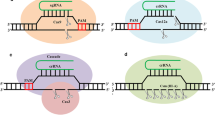Summary
We have used homologous recombination to disrupt the gene which codes for p34 and p31, two polypeptides related to a cAMP-binding protein (CABP1) in Dictyostelium discoideum. By screening a total of 80 independent transformants by Southern blotting, four mutants have been isolated. Two of these mutants were analyzed in detail. Our results indicate that, while a null allele has not been obtained, both mutants express drastically reduced levels of truncated p34 and p31. Phenotypic analysis has demonstrated that both of them grow significantly more slowly than wild-type controls when bacteria are used as a food source. Interestingly, this growth defect is not seen when the cells are cultured axenically. In addition, the mutants possess an altered developmental profile. They complete development approximately 3 h later than wild-type controls. These results indicate that p34 and p3l play roles in both growth and development in this organism.
Similar content being viewed by others
References
Bain G, Grant CE, Tsang A (1991) Isolation and characterization of cDNA clones encoding polypeptides related to a Dictyostelium discoideum cyclic AMP-binding protein. J Gen Microbiol, in press
De Lozanne A, Spudich JA (1987) Disruption of the Dictyostelium myosin heavy chain gene by homologous recombination. Science 236:1086–1091
Early AE, Williams JG (1987) Two vectors which facilitate gene manipulation and a simplified transformation for Dictyostelium discoideum. Gene 59:99–106
Firtel RA, Bonner J (1972) Characterization of the genome of the cellular slime mold Dictyostelium discoideum. J Mol Biol 66:339–361
Firtel RA, Van Haastert PJM, Kimmel AR, Devreotes PN (1989) G protein linked signal transduction pathways in development: Dictyostelium as an experimental system. Cell 58:235–239
Grant C, Tsang A (1990) Cloning and characterization of cDNAs encoding a novel CAMP binding protein in Dictyostelium discoideum. Gene 96:213–218
Harloff C, Gerisch G, Noegel AA (1989) Selective elimination of the contact site A protein of Dictyostelium discoideum by gene disruption. Genes Dev 3:2011–2019
Kay RR (1989) Evidence that elevated intracellular cyclic AMP triggers spore maturation in Dictyostelium. Development 105:753–759
Kay CA, Noce T, Tsang AS (1987) Translocation of an unusual cAMP receptor to the nucleus during the development of Dictyostelium discoideum. Proc Natl Acad Sci USA 84:2322–2326
Kimmel A (1987) Different molecular mechanisms for cAMP regulation of gene expression during Dictyostelium development. Dev Biol 122:163–171
Konijn TM, Van de Meene JGC, Bonner JT, Barkley DS (1967) The acrasin activity of adenosine 3′-5′-cyclic phosphate. Proc Natl Acad Sci USA 58:1152–1154
Laemmli UK (1970) Cleavage of structural proteins during the assembly of the head of bacteriophage T4. Nature 227:680–685
Maniatis T, Fritsch EF, Sambrook J (1982) Molecular cloning: a laboratory manual. Cold Spring Harbor Laboratory Press, New York
Riley BB, Jensen BR, Barclay SL (1989) Conditions that elevate intracellular cAMP levels promote spore formation in Dictyostelium. Differentiation 41:5–13
Sussman M (1966) Biochemical and genetic methods in the study of cellular slime mold development. In: Prescott D (ed) Methods in Cell Physiology, vol 2. Academic Press, New York, pp 397–410
Tsang AS, Tasaka M (1986) Identification of multiple cyclic AMP binding proteins in developing Dictyostelium discoideum cells. J Biol Chem 261:10753–10759
Tsang AS, Grant C, Kay C, Bain G, Greenwood M, Noce T, Tasaka M (1988) Characterization of an unusual cAMP receptor and its related polypeptides in Dictyostelium discoideum. Dev Genet 9:237–245
Watts DJ, Ashworth JM (1970) Growth of myxamoebae of the cellular slime mould Dictyostelium discoideum in axenic culture. Biochem J 119:171–174
Williams JG (1988) The role of diffusible molecules in regulating the cellular differentiation of Dictyostelium discoideum. Development 103:1–16
Witke W, Nellen W, Noegel A (1987) Homologous recombination in the Dictyostelium actinin gene leads to an altered mRNA and lack of the protein. EMBO J 6:4143–4148
Author information
Authors and Affiliations
Additional information
Communicated by D.Y. Thomas
Rights and permissions
About this article
Cite this article
Bain, G., Tsang, A. Disruption of the gene encoding the p34/31 polypeptides affects growth and development of Dictyostelium discoideum . Mol Gen Genet 226, 59–64 (1991). https://doi.org/10.1007/BF00273587
Received:
Issue Date:
DOI: https://doi.org/10.1007/BF00273587




